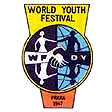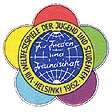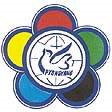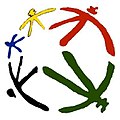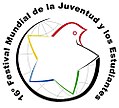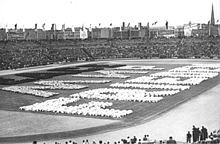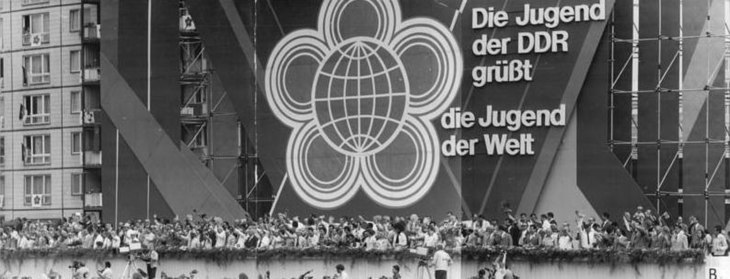World Festival of Youth and Students
The World Festival of Youth and Students (short: World Youth Games ) are irregular international youth meetings that were brought into being in 1947 by the World Federation of Democratic Youth (WBDJ). The participating youth and student associations are predominantly left-wing , often communist -oriented.
Chronicle of the World Festival
The WBDJ, founded on November 10, 1945, decided to hold world youth meetings; These meetings should “develop and strengthen the international friendship and understanding of the young people of the different countries, make an important contribution to the reconstruction of the world and the maintenance of peace and show by all appropriate means the life, the activity and the aspirations of the youth of the different countries ".
At the World Festival there is discussion and celebration, music and lectures are heard and offered. The events are politically and culturally shaped. During the Cold War in particular , they were repeatedly the subject of violent disputes, especially in 1959 and 1962, when they took place in countries outside the Eastern Bloc .
- 1947 in Prague - 17,000 participants from 71 countries
- 1949 in Budapest - 10,400 participants from 82 countries, including a delegation from the FDJ
- 1951 in East Berlin - 26,000 participants from 104 countries
- 1953 in Bucharest - 30,000 participants from 111 countries
- 1955 in Warsaw - 30,000 participants from 114 countries, including 1,500 FDJ members and 1,500 delegates from the Federal Republic of Germany and the Saar area
- 1957 in Moscow - 34,000 participants from 131 countries
- 1959 in Vienna - 18,000 participants from 112 countries, including 550 delegates from the FDJ
- 1962 in Helsinki - 18,000 participants from 137 countries, including 500 delegates from the FDJ
- 1968 in Sofia - 20,000 participants from 142 countries, including 700 delegates from the FDJ
- 1973 in East Berlin - 25,600 participants from 140 countries
- 1978 in Havana - 18,500 participants from 145 countries, including 200 delegates from the FDJ
- 1985 in Moscow - 26,000 participants from 157 countries
- 1989 in Pyongyang - 10,000 participants from 177 countries, including 850 delegates from the GDR
- 1997 in Havana - 12,325 participants from 132 countries
- 2001 in Algiers - more than 7,000 participants from 140 countries
- 2005 in Caracas - more than 17,000 participants from 144 countries
- 2010 in Pretoria - more than 15,000 participants from 126 countries
- 2013 in Quito - 8,500 participants from 80 countries
- 2017 in Sochi - 25,214 participants from 185 countries
World Festival logos
World Festival in German-speaking countries
1951 East Berlin
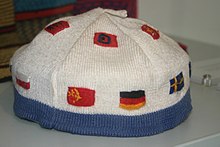
The first World Festival in the German Democratic Republic took place from August 5th to 19th, 1951 in East Berlin . The opening and closing ceremonies were held in the Walter Ulbricht Stadium . On the occasion of the games, the German Sports Hall was also built at short notice . About 26,000 participants from 104 countries officially attended the youth meeting. The GDR used the World Festival intensively as an opportunity to gain international reputation. The festival hymn In August, the roses bloom became part of the popular songs of the GDR. The composer Günter Kochan wrote the song Signals of the Youth for the World Festival (text: Paul Wiens ).
The FDJ , which was banned in the Federal Republic of Germany as anti-constitutional on April 24, 1951 , called for participation in the World Festival. The Chairman of the Preparatory Committee for the World Youth Festival in 1951 was the Bremen pastor Johannes Oberhof . On July 3, 1951, the Hessian Minister of the Interior banned advertising for the World Festival in a public letter to the regional presidents, lords and district administrators:
“... The event is a major political demonstration for the Soviet zonal regime and at the same time serves to fight against the democracy of the Western peoples with the aim of leading the youth of the Federal Republic on a wrong track and alienating them from the basic democratic order of the Federal Republic.
Insofar as the advertising and preparation of the 'World Festival' are carried out in the Federal Republic, they are therefore directed against the constitutional order in the Federal Republic, so that associations of people who prepare, support or operate this event according to Art. 9 Para. 2 of the Basic Law are prohibited by law.
On the basis of Art. 9 Para. 2 in conjunction with Art. 17 of the Hessian Constitution, I instruct you to prevent any activity of such associations as well as any propaganda for the World Festival by any police means. I request that all propaganda material, signature and donation lists be secured. Business and meeting rooms that are used for an activity that is prohibited according to this rule must be closed. "
Young people willing to participate were in some cases prevented by federal authorities from leaving the country and thus from participating. By July 28, 1951, more than 6,000 FDJ people had been forcibly brought back to their homes from the border. Transport companies that supported actions by the banned West FDJ were threatened with fines. At the Lower Saxony police alone , 11,000 police officers were put on alert.
Participants from Switzerland were also prevented from entering the country.
Around one million festival participants, i.e. around half, accepted the invitation of Governing Mayor Ernst Reuter to visit the west , despite the temporary closure of the S-Bahn and U-Bahn connections from East to West Berlin . There the occupying powers, charities and companies offered a program to look after the visitors. Kurt Schumacher , Jakob Kaiser and John Jay McCloy spoke at rallies and discussion events . The guests were happy to take advantage of the free catering in youth homes because of the supply shortages in the Eastern sector, as well as the distribution of 750,000 books, newspapers and brochures as well as 170,000 free tickets for cinema and theater visits. The FDJ chairman Erich Honecker then sent 10,000 members of the FDJ in marching formations to West Berlin, who shouted slogans in chants and distributed leaflets. This led to street battles with the West Berlin police in the districts of Wedding , Kreuzberg and Neukölln . Eleven police officers were among the many injured. Arrest warrants were issued against 47 of the 162 arrested persons, others were imprisoned by an express court for several days. The incident was investigated by the Groscurth committee .
The Dutch documentary filmmaker Joris Ivens shot about the III. World Festival the documentary friendship wins .
1959 Vienna
18,000 official participants met in Vienna from July 26th to August 4th. This means that the number of participants has almost halved compared to the World Festival two years earlier. The Viennese event differed from the previous World Festival in the large number of young people from Africa and Asia. Participants from Germany came a. by the Free German Youth and the Liberal Student Union of Germany . The Viennese press had decided not to publish anything about the events.
1973 East Berlin
In 1973 the World Festival took place again in East Berlin from July 28th to August 5th. Around eight million visitors with 25,600 guests from 140 countries came together in the nine days of the event. Beat and rock music and songs from singing clubs were played on 95 stages . The festival song that won a competition was: "The young world is visiting Berlin, and it doesn't care if it suits the enemy". Deputy head of the organizing committee was the employee in the FDJ Central Council Wolfgang Berghofer .
Due to the close proximity to the Woodstock Festival in the USA, western observers called the 1973 World Festival the "Woodstock of the East". Behind this was the largest police action since the suppression of the popular uprising in June 1953 and the construction of the Wall in 1961. The criminal police department reported 2073 arrests of "anti-social" people in Berlin and the surrounding area alone, and 604 people were admitted to psychiatric institutions.
The GDR documentary Who Loves the Earth describes the X. World Youth Games.
A delegation of 800 participants from the Federal Republic of Germany went to the World Festival, which was organized by the initiative committee X. World Festival ( AK Festival (including SDAJ , VDS and MSB Spartakus ) and the X. World Festival coordination group ( Jusos , DGB youth , young democrats and others)) was put together. At the Bebelplatz in East Berlin, the then Juso chairman Wolfgang Roth was able to speak; it was the first official speech by an SPD board member in the GDR / SBZ since the forced unification of the SPD and KPD in 1946 . The order to shoot at the wall was suspended for the time of the games .

The Ministry for State Security (MfS) prevented 2720 “negative people” from traveling to East Berlin until June 28, 1973, and arrest warrants were issued for 2073 people. Stasi employees disguised as FDJ members were sent to the discussion points that had to represent the politics of the party and government of the GDR in critical discussions. You should also collect and document dangerous leaflets and regularly submit detailed reports on your work. In addition, the GDR participants received ideological training before the World Festival. For this purpose, the FDJ work of the previous year, for example the FDJ academic year , was ideologically geared towards the youth meeting throughout the GDR.
As in 1951, the main venue was to be the Walter Ulbricht Stadium . After Ulbricht was deposed as SED chairman in May 1971, it was renamed the World Youth Stadium immediately before the opening of the Games . When Ulbricht, the head of state of the GDR , died during the World Festival, the festival did not stop. Ulbricht's name was largely removed from GDR historiography shortly after his death. At the same time, the nearby Walter-Ulbricht-Stadion underground station , which has been a ghost station since the Wall was built, was renamed the World Youth Stadium .
19th World Festival in Sochi 2017
The General Council of the WBDJ decided to host the 19th World Festival of Youth and Students in Russia . The main reason for this decision was the 100th anniversary of the October Revolution .
The official motto of the festival was: »For peace, solidarity and social justice, we fight against imperialism. By honoring our past, we build the future «.
As the initiator of the festival, the WBDJ criticized the fact that the Russian organizers did not take sufficient account of the socialist idea of the festival. In fact, the character of the event differed significantly from the events organized in Soviet times. Some of the main sponsors (such as Sberbank or Gazprom ) were very prominent.
The World Festival received media attention mainly from Russia. Western media reported sparse and criticized the event as an image campaign for Russian President Putin .
Participating organizations from the German-speaking area were the SDAJ from Germany , the KJÖ from Austria and the Communist Youth of Switzerland.
literature
- Andreas Ruhl: Stalin cult and Red Woodstock. The 1951 and 1973 World Youth Festival in East Berlin. Tectum Verlag, Marburg 2009. ISBN 3-8288-2020-4 .
- Denise Wesenberg: “Under operational control”. The 10th World Festival of Youth and Students in 1973 in East Berlin. Landeszentrale f. political picture. Thuringia, Erfurt 2007, ISBN 3-937967-26-5 .
- Wolf Oschlies: World Festival of Youth and Students. History, Mission and Earnings of Communist Youth Festivals. Federal Institute for Eastern and International Studies, Cologne 1985.
- Erwin Bresslein: Druzhba! Friendship? From the Communist Youth International to the World Youth Festival. Fischer-Taschenbuch-Verlag, Frankfurt / M. 1973, ISBN 3-436-01689-6 .
- Klemens Vogel: The World Festival then and now, Federal Agency for Political Education.
Web links
- World Festival
- The World Youth Song of 1947 (MP3; 5.0 MB)
- Vienna 1959
- Klemens Vogel: The World Festival then and now
- Erwin Breßlein: History and Problems of the World Youth Festival
- Sofia 1968, stamp series with logo
- Article with background information and images on the 1973 World Festival in East Berlin on jugendopposition.de.
Individual evidence
- ↑ http://russia2017.com/en/ (link not available)
- ↑ Politics, culture and society commemorations: August 5, 2001
- ↑ Jens-Axel Götze: Neoclassicism for youth and athletes. In: friedrichshainer-chronik.de. February 2006.
- ↑ Reinhard Bockhöfer: Pastor Johannes Oberhof's dearly paid engagement against rearmament . In: Helmut Donat , Andreas Röpcke (eds.): "Lower your arms - your hands reached!" Peace movement in Bremen 1898–1958. Page 179
- ^ Prohibition of advertising for the "World Festival of Youth and Students for Peace" in Berlin on July 3, 1951 . In: The Hessian Minister of the Interior (ed.): State Gazette for the State of Hesse. 1951 no. 27 , p. 374 , point 603 ( online at the information system of the Hessian state parliament [PDF; 1.9 MB ]).
- ↑ Heiner Timmermann (Ed.): The GDR in Europe - between isolation and opening , p. 471
- ↑ 1951 World Festival in Berlin - A Journey with Difficulties ( Memento from June 11, 2008 in the Internet Archive )
- ^ Hans J. Reichhardt, Joachim Drogmann, Hanns U. Treutler, Landesarchiv Berlin, Department of Contemporary History (editing): Berlin. Chronicle of the years 1951–1954. Heinz Spitzing Verlag, Berlin 1968, p. 152 f .; there also the figures.
- ↑ Klemens Vogel: The World Festival then and now. In: Website of the Federal Agency for Civic Education. July 16, 2003.
- ^ Andreas Ruhl: Stalin cult and Red Woodstock. The 1951 and 1973 World Youth Festival in East Berlin. (= Scientific articles from Tectum Verlag: Geschichtswwissenschaft. Volume 7). Tectum Verlag, 2009, ISBN 978-3-8288-2020-3 .
- ↑ World Festival of Youth and Students in the Internet Movie Database (English)
- ↑ Hans Gresmann: Vienna: battle of words and chants. In: Die Zeit 32/1959. 7th August 1959.
- ^ A b Stefan Wolle: World Youth Games in East Berlin - The Woodstock of the East. In: Spiegel Online . July 28, 2008.
- ^ GDR injustice - Woodstock of the East. In: Der Spiegel 35/1996. August 26, 1996
- ^ Christian Neef: The red Woodstock. In: Spiegel history. 3/2015. May 27, 2015.
- ^ Carsten Schröder: Behind the scenes of the Xth Festival. In: Website of the Federal Agency for Civic Education. July 25, 2003.
- ↑ Off to Russia! - World Festival of Youth and Students. Retrieved September 8, 2018 (German).
- ↑ mdr.de: Russia under criticism for World Festival | MDR.DE . ( mdr.de [accessed on September 8, 2018]).



